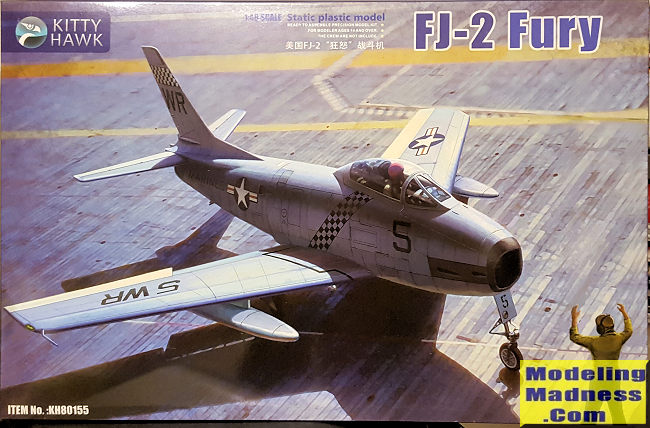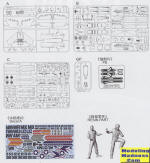
Kitty Hawk 1/48 FJ-2 Fury
| KIT #: | KH80155 |
| PRICE: | $ |
| DECALS: | Five options |
| REVIEWER: | Scott Van Aken |
| NOTES: | 2019 tooling |

| HISTORY |
From Wikipedia:
By 1951, the Navy's existing straight-wing fighters were much inferior in performance to the swept-wing Soviet MiG-15 then operating in the Korean War; the swept-wing fighters in the Navy's development pipeline, such as the Vought F7U Cutlass and Grumman F9F Cougar, were not yet ready for deployment.
As an interim measure, the Navy's Bureau of Aeronautics ordered a direct development of the swept-wing F-86E Sabres as the FJ-2. As the F-86 had not been designed to be carrier-capable, this involved some risk, but Navy pilots had observed that the F-86A actually had a lower landing speed than the F9F Panther. During carrier qualification trials the Navy informed Grumman that if the F9F-5 stall speed was not reduced by 12 mph (10 kn; 19 km/h) it would be removed from carrier operations at the same time that the FJ-2 was already making its debut into navy squadrons. North American's chief engineer at the time stated that the swept-wing Sabre had handling and stall characteristics at low speeds comparable to the best straight winged airplanes. The urgency behind the program was such that 300 (later reduced to 200) FJ-2 fighters were ordered before the prototypes had flown.
The first prototype to fly was actually the third aircraft ordered: Designated XFJ-2B and first flown on 27 December 1951, it differed only from a standard F-86E-10 in its armament, having four 20-mm Colt Mk 12 cannons instead of the six Colt-Browning M3 .50 machine guns of the Sabre. The second and third aircraft to fly were designated XFJ-2 and lacked armament, but were modified to be carrier-capable: They had arrester hooks and longer nosewheel legs to increase angle of attack at take-off and landing, and catapult fittings. In August 1952 carrier trials were flown on USS Midway, followed by carrier qualification trials on USS Coral Sea in October–December 1952. Results were less than satisfactory: Low-speed handling was considered poor, while the arrester hook and nose gear leg were insufficiently strong.
The first production aircraft flew on 22 November 1952. This FJ-2 incorporated further modifications for carrier operations: The track of the main landing gear was widened by eight inches, the outer wing panels folded upward, and the windscreen was modified to give the pilot a better view during approach. The FJ-2 also featured an all-moving "flying tail" without dihedral. Because of problems experienced during launches with steam catapults, a number of FJ-2 later received a stronger nosewheel strut. Outwardly, the FJ-2 was hard to distinguish from an F-86, apart from navy paint and the gun muzzles of the 20 mm cannons. The engine was the General Electric J47-GE-2, a navalized version of the J47-GE-27 used in the F-86F. The naval modifications of the FJ-2 had increased weight by about 500 kg over the F-86F, but had not succeeded in delivering a fully carrier-capable fighter. A decision had already been made to give it to land-based squadrons of the US Marine Corps.
Construction was slowed due to demand for the F-86 in Korea; the FJ-2 was not produced in large numbers until after that conflict had concluded. Only seven aircraft had been delivered by then end of 1953, and it was January 1954 before the first aircraft was delivered to a marine squadron, VMF-122. The Navy preferred the lighter F9F Cougar due to its superior slow-speed performance for carrier operations, and the 200 FJ-2 models built were delivered to the United States Marine Corps. The marines did make several cruises aboard carriers and tried to solve the type's carrier handling problems, but the FJ-2 was never really satisfactory. In 1956, the FJ-2 already disappeared from front-line service, and reserve units retired it in 1957.
| THE KIT |
 1/48
fans of naval aircraft have been waiting quite a while for the early Fury
variants and Kitty Hawk has delivered on the first one, the FJ-2. Typical of
Kitty Hawk, the kit is designed to have everything open and since this is a
naval aircraft, it can have its wings folded as well.
1/48
fans of naval aircraft have been waiting quite a while for the early Fury
variants and Kitty Hawk has delivered on the first one, the FJ-2. Typical of
Kitty Hawk, the kit is designed to have everything open and since this is a
naval aircraft, it can have its wings folded as well.
The kit begins by having you build up the cannon bays. If you are going to have those closed, just put in the guns and leave out the rest. You will see the end of the barrels by peering down the troughs. It will also add a bit of weight. Do not leave the bays off entirely as they hold the cockpit in place. The 'pit is standard fare and the small etched fret that is included is for the seat harness.
Full intake trunking is provided as it also houses the nose gear well. It will be interesting to see how KH deals with the larger intake of the FJ-3 should they decided to do one. The cockpit sits atop this and this is all trapped in the forward fuselage halves. The kit is designed so you can leave off the rear fuselage to show the engine. Many of us who have done kits like this will find a way to simplify things if closing everything up and one is to glue front and rear fuselage halves together.
Once the forward fuselage is done, the instructions turn to the wings. Most of the main gear wells are molded in place, but there are a few bulkheads to attach to the inner section prior to assembling that. Outer sections are then assembled. Again, if doing straight wings, one may wish to glue inner and outer halves first. The kit comes with extended slats and flaps. There are also separate ailerons. What you don't get, but you can make are wing fold jury struts. These kept the wings steady in winds with the wings folded.
As with the nose gear, the main gear is to be assembled before finally joining all the big bits. I certainly don't build models like this so I'm not sure how that sort of thing really works out. Next one builds up the engine and attaches it along with the three aft fuselage sections together. The tail hook and speed brakes are all to be built lowered/open so you'll probably have to do some fiddling to model these closed. You also have optional aft fuselage engine cooling scoops but the instructions are mum on which is for which markings option.
The final steps are joining the three major subassemblies
together, building up the gun ammo boxes and doors, along with attaching the
drop tanks. You are also told to build up the Sidewinders and pylons, but to my
knowledge, the Sidewinder didn't really see fleet use until late 1956, by which
time the FJ-2 was out of fleet service. So leave those off. As another note,
this kit comes with reinforced rudder and tailplanes. This is not corre ct
for most FJ-2s so some filler work will be required. I did some google photo
searching and found the vast majority of FJ-2s did not have these
reinforcements. However, one period photo of a reserve aircraft had them as did
some museum planes so it seems these were either very late production or some
aircraft had them retrofit. As a nice bonus, you get two crew figures to go
along with your kit
ct
for most FJ-2s so some filler work will be required. I did some google photo
searching and found the vast majority of FJ-2s did not have these
reinforcements. However, one period photo of a reserve aircraft had them as did
some museum planes so it seems these were either very late production or some
aircraft had them retrofit. As a nice bonus, you get two crew figures to go
along with your kit
Tom has given a long piece on the decals in yesterday's build article so I'll only say that they are very nicely printed. I should also mention that this will probably need some nose weight, though none is suggested. Your call.
| CONCLUSIONS |
I am pleased to see this one and am looking forward to building it. It will not be a slap together kit as no Kitty Hawk kit is. However, it can be built into a very nice replica as long as you take your time building it. It will be interesting to see how the aftermarket people treat it.
| REFERENCES |
https://en.wikipedia.org/wiki/North_American_FJ-2/-3_Fury
The North American Sabre, by Ray Wagner, 1963, Doubleday
November 2019
Copyright ModelingMadness.com. All rights reserved. Thanks to Glen
Coleman and Kitty Hawk
for the review kit. You can find this kit at your favorite hobby shop
or on-line retailer. If you would like your product reviewed fairly and fairly quickly, please
contact
the editor or see other details in the
Note to
Contributors. Back to the Main Page
Back to the Review
Index Page
Back to the Previews Index Page